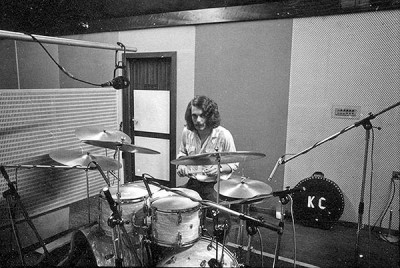1969 was a dynamic year for King Crimson. Within 12 months we rose from obscurity to world fame - a meterioric rise which took us all by suprise. The band gave me the opportunity to explore new attitudes in drumming and the freedom for expression that I had been looking for. The music developed a life of it’s own, perhaps in spite of, or because of the different energies of the players. And I remember how quickly and easily we wrote and arranged songs. Everyone had their own agendas and somehow they crossed over sufficiently to create something magical - obviously the right amount of friction whether overt or covert produces results. We were five young individuals committed to making dangerous, powerful, original, spontaneous music, forcing our way through previous rock and jazz boundaries.
The history of the original King Crimson and it’s members has been well documented by Robert, and I must confirm much of what he and other members have said about the band. Ian’s contribution was lyrical flute playing, blistering saxophone solos, and sensitivity in free sections. His strong and beautiful melodies and compositions gave the music the romantic quality it sometimes needed to remain in balance. Peter became the “fifth member” because of his dedication, imagination and enthusiasm. His penetrating and dramatic words not only gave the band it’s name, but also broke new ground in rock music - and his skill with lighting was an integeral part of the live performance. Greg gave a powerful majestic voice and stage presence to the band - his solid bass playing generously supported our wild musical adventures. Robert gave the band intensity, controlled power, dark, searching, brilliant, inspiring and totally unique guitar playing, together with a determination to succeed and a spirit of adventure. It is interesting that King Crimson should be so successful in the midst of the love and peace movement.
Most of the tracks on this official live bootleg do demonstrate how the music had a life of it’s own, particularly the improvised and dangerous sections where I felt, and I think Robert would agree, that the music was playing us, we had entered an area of consciousness where we were being used as instruments and all we had to do was trust in the process of reception and transmission.
Just for the record, I must say that KC’s music was not induced by the use of “certain substances”, although many people have asked me, “how could you make music like that without drugs?” - well we did. I certainly did not wish to disturb the flow of natural energy and imagination. An example of this natural high was when Robert, Ian and I were playing the free section in Moon Child at Wessex Studios and responding to each other freely. Going from the studio to the control room I thought we’d played well. But it was only on playback that I really heard what had happened. We had gone into a free section not knowing where it would lead or how long it would be. We were exploring in unknown territory, not knowing what we might find. What we found on listening back, was an “incidence of coincidence” between guitar, flute and drums that I was not fully aware of while playing and I immediately said, “did we really play that?” It has been suggested that the section should have been edited or that it was self indulgent, but I am glad we honoured the original.
We gained increasing confidence in free sections and played without a “safety-net”, sometimes resulting in some cliff-hanging moments - very exciting for us and the audience. We also began to use more hard improvisation within the structured pieces and alongside the vocal lines. The band was usually at peak expression which gave rise to new ideas almost every night developing in the song. Having set up the freedom to do this, we were always stimulated. This would partly explain why the KC studios sessions can be substantially different from the live performances.
On listening to these tracks I am still amazed at the energy, inventiveness, and sheer courage of the band, even today after 28 years. I hope the listener will enjoy the exposure to the rough raw original KC in live performance as much as I do.
Michael Giles, January 1997


